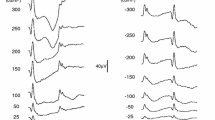Abstract
The purpose of the study was to evaluate the effects of pre-adaptation and ambient room luminance on the multifocal ERG (mfERG). We recorded mfERGs on 18 normal subjects (average age 32) using a VERIS system, with either 61 or 103 stimulus hexagons. mfERGs were recorded sequentially under different conditions of pre-adaptation and room lighting. Changing pre-adaptation conditions between darkness for 20 min, or light at 1.43 log cd/m2 for 10 min, had essentially no effect on the mfERG, regardless of ambient room lighting. However, mfERG parameters were sensitive to the level of ambient room lighting during the recordings. As room luminance was increased from darkness, there was a gradual attenuation of N1 and P1 amplitudes both centrally and peripherally that approached 25% reduction at 1.6 log cd/m2, and a decrease in P1 time-to-peak. These effects were greatest in the blind spot. The mfERG is largely independent of pre-adaptation conditions, but waveform amplitudes and times-to-peak diminish with increasing ambient room luminance. The exaggerated attenuation of signals in the blind spot with room lighting suggests that mfERGs recorded in the dark are contaminated by light scattered to dark-adapted peripheral retina. The most stable mfERG recording condition appears to be a fully lighted room (1.6 log cd/m2).
Similar content being viewed by others
References
Marmor M, Zrenner E. Standard for clinical electroretinography (1999 update). Doc Ophthalmol 1999; 97: 143–56.
Lachapelle P. Analysis of the photopic electroretinogram recorded before and after dark adapatation. Can J Ophthalmol, 1987; 22: 354–61.
Gouras P, MacKay C. Growth in amplitude of the human cone electroretinogram with light adaptation. Invest Ophthalmol 1989; 30: 625–30.
Peachey N Alexander K, Fishman G. Visual adaptation and the cone flicker electroretinogram. Invest Ophthalmol Vis Sci 1991; 32(5): 1517–22.
Weiner A, Sandberg MA. Normal change in the foveal cone ERG with increasing duration of light exposure. Invest Ophthalmol Vis Sci 1991; 32: 2842–5.
Kondo M, Miyake Y, Piao C, Tanikawa A, Horiguchi M, Terasaki H. Amplitude increase of the multifocal electroretinogram during light adaptation. Invest Ophthalmol Vis Sci 1999; 40: 2633–7.
Author information
Authors and Affiliations
Rights and permissions
About this article
Cite this article
Chappelow, A.V., Marmor, M.F. Effects of pre-adaptation conditions and ambient room lighting on the multifocal ERG. Doc Ophthalmol 105, 23–31 (2002). https://doi.org/10.1023/A:1015713029443
Issue Date:
DOI: https://doi.org/10.1023/A:1015713029443




